Greetings Readers,
After about a month in Italy, my time there had finally come to an end. I took my Italian language final and submitted my last work to Dr. Fleck. Everything was packed up by Wednesday night. We said goodbye to the wait staff and owner of the restaurant around the corner who we had befriended over the course of our stay in Siena. Then, on Thursday morning, we left for Rome.
To get to Rome, we traveled for the better part of a day. Moving a group of seventeen people with at least one piece of luggage each on cramped trains is very stressful. Due to the lack of space on regional trains, a few students and I opted to stay with some of our group’s luggage and just sat on the bags near the door of the compartment. Even though one train was about 20 minutes late, we still managed to catch our connection and arrived at the refurbished monastery, where we were staying, on time. After we moved into our rooms, where we would be living for the next three days, we walked to dinner.
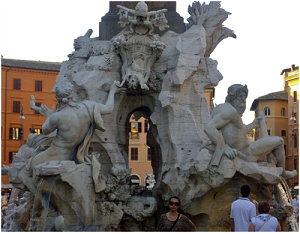 On the way to the restaurant, we passed a number of historical sites, such as The Fountain of Four Rivers.
On the way to the restaurant, we passed a number of historical sites, such as The Fountain of Four Rivers.
 Located in Piazza Navona, the work of art was designed by Gian Lorenzo Bernini in 1651 for Pope Innocent X. Bernini’s work symbolizes the four rivers, the Nile, Danube, Ganges, and Platte, whose continents, Europe, Asia, Africa, and the Americas, throughout which the papal authority had spread. The papal symbol, the two crossed keys, with the crest of the pope can be seen over the arch of the fountain. On top of the combination of architecture and sculpture, there is an Egyptian obelisk.
Located in Piazza Navona, the work of art was designed by Gian Lorenzo Bernini in 1651 for Pope Innocent X. Bernini’s work symbolizes the four rivers, the Nile, Danube, Ganges, and Platte, whose continents, Europe, Asia, Africa, and the Americas, throughout which the papal authority had spread. The papal symbol, the two crossed keys, with the crest of the pope can be seen over the arch of the fountain. On top of the combination of architecture and sculpture, there is an Egyptian obelisk.
On the top of the obelisk, there is a dove with an olive twig, which is the Pamphili family emblem of Pope Innocent X.
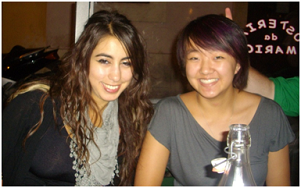 We ate dinner at a small restaurant with outdoor seating. I splurged and ordered a pasta alla carbonara. The dish was made up of pasta, egg, cheese, and bacon. Everybody agreed it was one of the best dishes of the night. While we were waiting for our meal, we took the opportunity to smile for a few photos.
We ate dinner at a small restaurant with outdoor seating. I splurged and ordered a pasta alla carbonara. The dish was made up of pasta, egg, cheese, and bacon. Everybody agreed it was one of the best dishes of the night. While we were waiting for our meal, we took the opportunity to smile for a few photos.
This is a picture of Candace and me.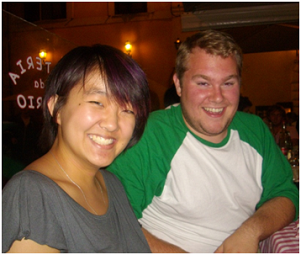 Even though Candace is a few years older than me we got along great. She’s from the ERAU campus in Prescott, Arizona and just graduated with a bachelor’s degree in electrical engineering. Candace is pretty funny and we like a lot of the same things. I was fortunate that she chose to room with me. Oh, and before I forget, the alien antenna is courtesy of Charles. He has a crazy sense of humor, but can also be very pragmatic. Currently he’s studying aeronautical science at the Daytona Beach campus.
Even though Candace is a few years older than me we got along great. She’s from the ERAU campus in Prescott, Arizona and just graduated with a bachelor’s degree in electrical engineering. Candace is pretty funny and we like a lot of the same things. I was fortunate that she chose to room with me. Oh, and before I forget, the alien antenna is courtesy of Charles. He has a crazy sense of humor, but can also be very pragmatic. Currently he’s studying aeronautical science at the Daytona Beach campus.
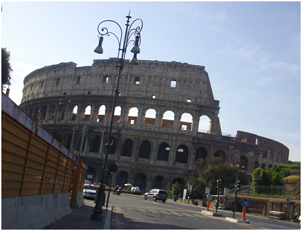 The next morning we started out bright and early. The first ancient building that we visited was the Colosseum.
The next morning we started out bright and early. The first ancient building that we visited was the Colosseum.
The elliptical amphitheater was completed in 80 AD and could seat up to 50,000 people. The Colosseum was used for gladiator fights, mock sea battles, executions, dramas, and hunting wild animals. The participants, such as people and 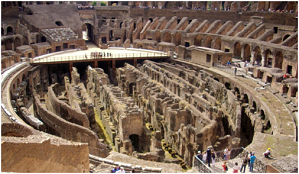 animals, in these public entertainments were housed in the hypogeum, a series of tunnels and cages underneath the floor of the main arena. In addition, there also used to be underground passages that connected the Colosseum to Ludus Magnus, a school where gladiators trained.
animals, in these public entertainments were housed in the hypogeum, a series of tunnels and cages underneath the floor of the main arena. In addition, there also used to be underground passages that connected the Colosseum to Ludus Magnus, a school where gladiators trained.
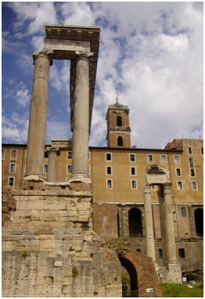
By this time of the day, the sun was high overhead and it was very warm. Luckily, on the way to our next destination, we were able to stop and get cool water from one of Rome’s many fountains. From there, we proceeded to walk inside the old Roman Forum.
This area contains the ruins of government buildings and used to be the center of ancient Rome. Commerce, business, and the administration of justice all took place here in the rectangular plaza located between the Palatine and Capitoline Hills. It was here that the Roman Republican government, an ancestor to the administration of the U.S., began. 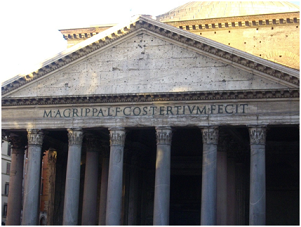
Following the Roman Forum, we went to the Pantheon.
The inscription on the front translates roughly to “Marcus Agrippa son of Lucius, having been consul three times made it.” The pediment, the triangular top stone, used to contain sculpture depicting the battle of the Titans. The dome is made up of a series of intersecting arches. The heaviest building materials were used at the base of the structure while the lightest, such as pumice, were used at the top. The highest point of the dome is actually an oculus, a circular opening in the center of the roof, is lined with bronze and lets in natural light.
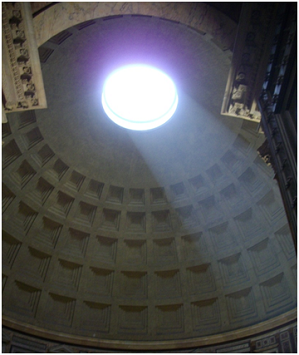
The Pantheon was created to honor the pagan gods of ancient Rome. Today, however, it is used to house the tombs of Italian kings and the famous Renaissance painter Raphael.

From the Pantheon, we made our way across the city to the Vatican. Along the way, we crossed Ponte Sant’Angelo. The bridge spans the Tiber River and was completed in 134 AD by the Emperor Hadrian.
In 1669, Pope Clement IX commissioned Gian Lorenzo Bernini to create a series of ten angels holding the instruments of Christ’s Passion. These tools include, but are not limited to, the crown of thorns, nail, cross, and lance.
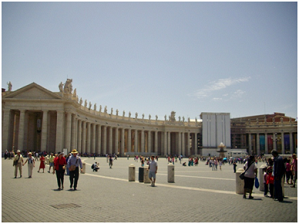 Eventually, we reached the Vatican. Vatican City is the smallest independent state in the world. It is here that the Pope, Pope Benedict XVI, lives. He is not only the Bishop of Rome, but also the head of the Catholic Church. One of the main entrances into the Vatican is St. Peter’s Square.
Eventually, we reached the Vatican. Vatican City is the smallest independent state in the world. It is here that the Pope, Pope Benedict XVI, lives. He is not only the Bishop of Rome, but also the head of the Catholic Church. One of the main entrances into the Vatican is St. Peter’s Square.
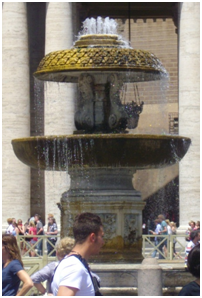
This piazza was also designed by Bernini, who was one of the most important artists in the baroque art movement. Visitor’s quickly realized that the square is clearly baroque due to the elliptical shape of the square and the elaborate, fancy stone work and design. In fact, Bernini used properties of the ellipse in creating St. Peter’s Square. For example, at each focus of the shape, he placed two fountains.
In the center, where the major and minor axes cross, he placed an Egyptian obelisk made out of red granite. The piazza is outlined in colonnades, rows of columns, which wrap around the square and symbolize the Catholic Church embracing visitors and worshippers alike in maternal arms. After we saw the square, we visited the Vatican Museum, which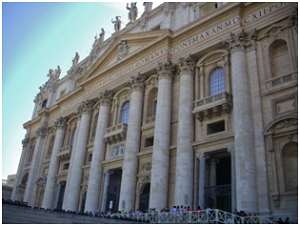 did not allow pictures. We saw Raphael’s School of Athens, which is a fresco depicting almost every great Greek philosopher. We were also able to visit the Sistine Chapel and see Michelangelo’s famous fresco on the ceiling. One of the many stories featured in the work of art is the story of Adam and Eve. The panel illustrating The Creation of Adam shows God reaching out to touch fingers with Adam. God appears to be reaching out of a human brain to perform this action, displaying Michelangelo’s knowledge of human anatomy. This gives evidence to the thought that the great Renaissance artist performed human autopsies even though they were illegal at the time.
did not allow pictures. We saw Raphael’s School of Athens, which is a fresco depicting almost every great Greek philosopher. We were also able to visit the Sistine Chapel and see Michelangelo’s famous fresco on the ceiling. One of the many stories featured in the work of art is the story of Adam and Eve. The panel illustrating The Creation of Adam shows God reaching out to touch fingers with Adam. God appears to be reaching out of a human brain to perform this action, displaying Michelangelo’s knowledge of human anatomy. This gives evidence to the thought that the great Renaissance artist performed human autopsies even though they were illegal at the time.
 After spending hours in the Vatican Museum, and getting lost multiple times, we exited the building and entered St. Peter’s Basilica.
After spending hours in the Vatican Museum, and getting lost multiple times, we exited the building and entered St. Peter’s Basilica.
It is the largest Christian Church in the world and is one of the holiest sites of Christianity. Each year, many people make a pilgrimage to visit St. Peter’s Basilica.
This church is cruciform in shape and contains multiple chapels, altars, and tombs of popes. In the picture, Bernini’s baldacchino, the canopy over the papal altar, is visible. The four huge undulating columns are made of bronze and the work as a whole is the epitome of baroque architecture.
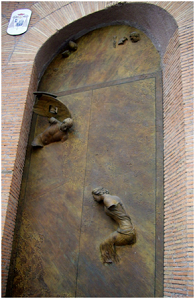 Following our visit to the Vatican, we returned to the refurbished monastery and recovered from the twelve hours of walking and incredible heat and humidity. While resting in my room, I contacted my friend John who is stationed in Naples with the Navy. I first met John four years ago on a People to People trip to the United Kingdom and Ireland. We kept in contact over the years and he was ecstatic to find out that I would be in Italy. He decided to come and visit while I was in Rome. That evening, a group of my fellow students and I met John and his friend at the Rome Hard Rock Café. We ate and talked the night away. After saying goodbye to John and leaving the restaurant, we decided to use the Roman metro system because we thought it would be an easier way to get back to the monastery. Unfortunately, certain subway lines only run until about 10 PM. While we’re not exactly sure how, we ended up on the back side of the Vatican, which was off our map. Eventually after walking around for about an hour to an hour and a half, we found our way back to the residence.
Following our visit to the Vatican, we returned to the refurbished monastery and recovered from the twelve hours of walking and incredible heat and humidity. While resting in my room, I contacted my friend John who is stationed in Naples with the Navy. I first met John four years ago on a People to People trip to the United Kingdom and Ireland. We kept in contact over the years and he was ecstatic to find out that I would be in Italy. He decided to come and visit while I was in Rome. That evening, a group of my fellow students and I met John and his friend at the Rome Hard Rock Café. We ate and talked the night away. After saying goodbye to John and leaving the restaurant, we decided to use the Roman metro system because we thought it would be an easier way to get back to the monastery. Unfortunately, certain subway lines only run until about 10 PM. While we’re not exactly sure how, we ended up on the back side of the Vatican, which was off our map. Eventually after walking around for about an hour to an hour and a half, we found our way back to the residence.
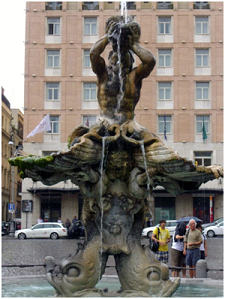 During the morning of our last day in Rome, the first place we visited was the Baths of Diocletian.
During the morning of our last day in Rome, the first place we visited was the Baths of Diocletian.
They used to be the most impressive baths in all of Rome and were the largest of the imperial pools. Today, even though some parts of the building have been preserved as baths, other rooms have been converted for other uses. For example, in one of the two circular rooms has been converted into a church, while the frigidarium, where the cold pools were located, is now a basilica. Other parts of the building are now part of the Roman National Museum.
When we left the baths, we walked across the Piazza Barberini, at the center of which is the Triton Fountain.
The statue was commissioned by Pope Urban VIII and created by Bernini in 1642. Triton was a sea god in Greco-Roman legends. The sea god rests on the tails of four dolphins that are intertwined with the papal symbol of the crossed keys and the Barberini family crest of the three bees. Originally, the spout of water used to be much higher. This, in combination of the pose of the Triton, makes the fountain very dramatic.
 The last tourist attraction we visited as a group with our professors was the Spanish Steps.
The last tourist attraction we visited as a group with our professors was the Spanish Steps.
This is the widest staircase in all of Europe and spans from the Piazza di Spagna to the Piazza Trinita dei Monti. It was at this point in time, that Professor Fleck and his wife said goodbye to us and left. The group of study abroad students said their goodbyes as well and separated. Some people needed to catch trains or the subway to get back to the airport. Others had the rest of the day to spend in Rome doing whatever we wanted. For me, that meant visiting the Borghese Gallery to examine the Bernini’s most famous works.
Part of my honors course work included an in-depth paper that would further examine a topic studied in class. I chose to study Gian Lorenzo Bernini’s marble statue Apollo and Daphne. Bernini was truly a genius when it came to sculpture. From the sheer amount of detail of Daphne’s fingers transforming into leaves to the look on her face as Apollo catches her, Bernini is amazing. The Borghese Gallery also had Bernini’s David, Pluto and Proserpina, and multiple works of Caravaggio, another great baroque artist. Originally, I thought that my two hour ticket would be ample time to example all of the works in the gallery. However, I found that I was one of the last people to leave and I only saw the first floor. It could be my honors geek speaking, but I thoroughly enjoyed myself just staring at Apollo and Daphne. If you ever find yourself in Rome and have some spare time, I most definitely recommend that you visit the Borghese Gallery.


